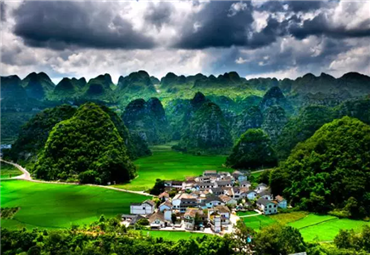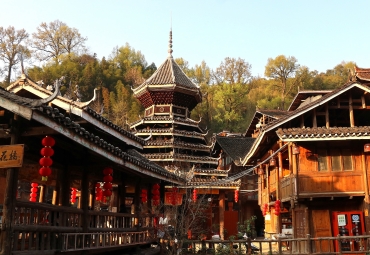Experiencing Guizhou's wild beauty

An aerial view of the Wujiang River in Yanhe Tujia autonomous county in Guizhou province.[Photo by Zhang Xiangrong/For China Daily]
With its wealth of natural resources, rare animals and plants, as well as history and ethnic cultures, Tongren is a great destination for winter tourism. A three-day stay will be enough for visitors seeking to explore the beauty of this city, which boasts magnificent mountains and hot springs.
Day 1: Fanjing Mountain
To protect its environment, the Fanjing Mountain scenic area has a daily visitor limit of 10,000. In Tongren, people often say that "there are 7 billion people in the world, but Fanjing Mountain can only accommodate 3 million each year, which means the world would have to line up for 2,000 years to visit the mountain one by one".
Such limitations only make the world natural heritage site even more attractive.
According to the local government website, since the fourth quarter of last year, more than 270,000 tourists have visited Fanjing Mountain, an increase of over 560 percent compared to the previous quarter.
In addition, tourism in Tongren, where Fanjing Mountain is located, made revenues of nearly 47 billion yuan in the first three quarters of last year, an increase of over 30 percent compared to the previous year.
What attracts tourists are the area's 7,000 species of plants and animals, 2,000 years of history, touching stories from the Red Army's Long March, and mountain trails above the clouds.
In 2018, Fanjing Mountain was added to the World Heritage List, becoming the 13th world natural heritage site in China and the 4th in Guizhou. Over the past five years, management of the Fanjing Mountain National Nature Reserve has intensified efforts to protect its environment.
According to Zhang Jinfu, deputy director of one of the reserve's management stations, the protected area has expanded from the original 428 square kilometers to 775 square km. The number of flora and fauna species under protection has also increased, from over 4,000 to more than 7,100, including 57 rare animal species, 83 rare plant species, and 21 nationally protected plant species.

A Francois' Langur and its cub are photographed in the Mayang River National Nature Reserve in Guizhou.[Photo provided to China Daily]
Data from the reserve shows that Fanjing Mountain is one of the world's rare genetic resource banks. It boasts 4.2 square km of primary forest and a large area of dove trees, a first-class protected tree which only exists in China, as well as a nationally protected wild plant and a species unique to China — the Guizhou Golden Snub-nosed Monkey — which is an endangered species on the IUCN Red List. Only about 800 exist in the world, all in Guizhou.
To reach the reserve's famous Golden Summit, it's possible to take a 3.5-kilometer cable car ride from Jiangkou county and then walk up several hundred meters of steep steps to reach the top.
It is the main peak in the Wuling Mountain Range, where Fanjing Mountain is located. In the morning, Golden Summit is often surrounded by clouds tinted red by the rising sun, a sight that is considered auspicious in Chinese culture.
The mountain is topped by a nearly 100-meter-high spire that takes Golden Summit to an altitude of just over 2,300 meters, and which is shrouded in mist all year round. Climbing it requires using the iron chains that have been attached to the rock, while navigating a flight of delicately carved stairs. It's a challenging feat, and one that attracts tourists wishing to take photos and leave their mark.
Those who choose not to take the cable car down the mountain can follow a 13.5-kilometer hiking trail from Golden Summit to the reserve's West Gate in Yinjiang county.
The trail is quiet. Walking above the sea of clouds through the primeval forest, hikers will encounter stones and plants along the way. The most impressive sight is the branches on both sides of the trail, covered with moss, which resembles a scene from Alice in Wonderland.
Occasionally, you can hear bird calls and see small animals scuttling through the leaves nearby. Visitors from the city are able to enjoy the beauty of returning to nature, and the other hikers we encountered on the trail seemed relaxed and happy, among them mountain enthusiasts from Europe, parents teaching their children about flora and fauna, and young urban professionals seeking an escape from city stress.
"Some people have even suggested that we should bottle the air here and sell it. Its negative oxygen ion content is unusually high," a forest ranger later joked.
Day 2: Hot springs
After the four-hour hike needed to complete the whole of the Fanjing Mountain trail, one good choice is to head west to neighboring Shiqian county, which is famous for its natural hot springs.
Shiqian is the country's first national-level scenic area for hot springs. The oldest facilities here can be traced back over 400 years to the Ming Dynasty (1368-1644), making this one of the oldest hot spring clusters in China.
Soaking in the outdoor pools in winter, when the air temperature hovers around 0 Celsius and the water at around 40 Celsius, is truly worth experiencing.
We met many local residents who said that they had been coming to the hot springs since childhood, and for whom weekend baths had become a habit.
"Regular bathing not only prevents cancer, beautifies the skin, and aids in weight loss and fitness, but also has good auxiliary medical effects on diabetes, hypertension, arthritis, neuralgia, and skin diseases," they eagerly told visitors from all over the country.
In the faces of the people of Shiqian, we saw pride in their hot spring culture and resources.
Looking through the records, we found a report in the Shiqian County Chronicle that read: "Bathing in winter warms the body and dispels cold, bathing in summer lightens the body and cools it, bathing at night ensures peaceful sleep, bathing when tired restores vitality, bathing when suffering from a cold induces sweating and quickly dispels the illness, and bathing for the elderly brings refresh and comfort."
In recent years, the local government has built a new hot spring town, injecting fresh vitality into this historic hot spring county.
Day 3: The nature reserve
After a hike and a trip to the hot springs, doing something more relaxing on the third day is another great choice.
Located in neighboring Yanhe county, the Mayang River National Nature Reserve is about two hours' drive from Shiqian.
It is famous for its population of Francois' langurs, a first-class national protected wild animal in China, which is listed as endangered by the International Union for Conservation of Nature. There are only around 2,000 of them in the world, and one-third live in Yanhe.
Lured by online promises of rare monkeys, we took to the winding mountain road full of anticipation. Anticipation that for me, unfortunately, soon gave way to a throbbing headache and the unpleasant pangs of carsickness. The one-and-half-hour journey felt like an eternity as the asphalt ribbon snaked deeper and deeper into the heart of the nature reserve.
But my misgivings melted away the moment we saw the first family of langurs. Wild and uncaged by zoo walls, these elegant primates with their soulful eyes and flowing black fur, were a revelation, and encountering them in their natural habitat, bathed in dappled sunlight, was a once-in-a-lifetime experience.
And then, there was the sunrise. As the first rays of dawn peeked over the crest of a mountain, turning the swirling mist below into a breathtaking ocean of clouds, our journey was etched in our memories, complete with its own haunting soundtrack.

Lanterns are used to decorate the ancient town of Tongren.[Photo by Yan Dongjie/China Daily]
All rights Reserved. 京ICP备13028878号-8







 Overview
Overview Guiyang
Guiyang Guian New Area
Guian New Area Liupanshui
Liupanshui Anshun
Anshun Qianxinan
Qianxinan Qiandongnan
Qiandongnan Qiannan
Qiannan Zunyi
Zunyi Tongren
Tongren Bijie
Bijie Guizhou commits to culture preservation and rural vitalization
Guizhou commits to culture preservation and rural vitalization Guizhou voice at 2025 national two sessions
Guizhou voice at 2025 national two sessions Meet the 'genius moms' at Shenzhen cultural fair
Meet the 'genius moms' at Shenzhen cultural fair 

